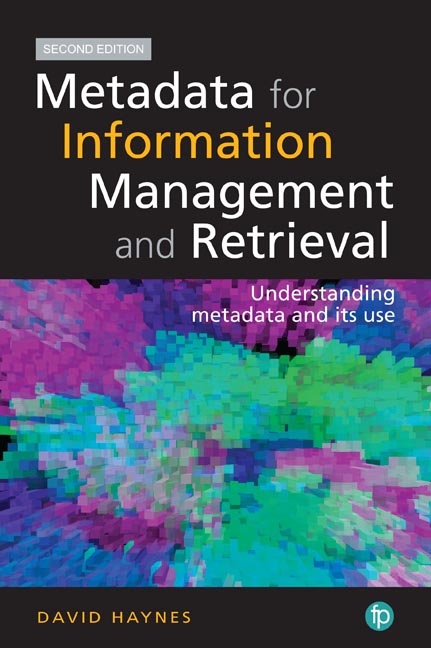Book contents
- Frontmatter
- Contents
- List of figures and tables
- Preface
- Acknowledgements
- PART I METADATA CONCEPTS
- PART II PURPOSES OF METADATA
- 5 Resource identification and description (Purpose 1)
- 6 Retrieving information (Purpose 2)
- 7 Managing information resources (Purpose 3)
- 8 Managing intellectual property rights (Purpose 4)
- 9 Supporting e-commerce and e-government (Purpose 5)
- 10 Information governance (Purpose 6)
- PART III MANAGING METADATA
- References
- Index
5 - Resource identification and description (Purpose 1)
from PART II - PURPOSES OF METADATA
Published online by Cambridge University Press: 08 June 2018
- Frontmatter
- Contents
- List of figures and tables
- Preface
- Acknowledgements
- PART I METADATA CONCEPTS
- PART II PURPOSES OF METADATA
- 5 Resource identification and description (Purpose 1)
- 6 Retrieving information (Purpose 2)
- 7 Managing information resources (Purpose 3)
- 8 Managing intellectual property rights (Purpose 4)
- 9 Supporting e-commerce and e-government (Purpose 5)
- 10 Information governance (Purpose 6)
- PART III MANAGING METADATA
- References
- Index
Summary
Overview
The chapter begins with a discussion of resource identifiers. It then considers how resource description is used to distinguish between different information resources. Some widely used identifiers such as ISBNs, DOIs, ISSNs, ISTCs and ISANs are described. ‘Description’ underpins other purposes such as retrieval and rights management. The chapter then looks at other metadata used for describing information resources by considering in turn: title; creator; bibliographic citation; date; format; and description.
How do you identify a resource?
Hider talks about metadata in terms of describing information resources, the primary purpose of which is to facilitate information access and use. He goes on to discuss data elements:
Each element describes an aspect or attribute of the information resource […] Clearly some attributes are more relevant in the provision of information access than are others.
(Hider, 2012, 15)He makes the point that metadata used to describe a resource is a representation of that resource. Taking this argument further, an identifier can be seen as an extreme form of representation of a resource – reducing it to a single sequence of digits or characters in a code. In effect an identifier could act as a surrogate for the resource, although they are more usually handled as labels for the resource.
Identifiers
A fundamental requirement of any description system is to have a way of uniquely identifying an item, so that it is clear what is being described. This is a particular concern in online records management, where there are different levels of aggregation. Is the resource being described as a single document, a series of documents on a particular topic, or a collection of items? For a small collection, an identifier could simply be the title of a book or piece of music. However, with even quite modest collections ambiguity becomes a significant issue, as when two different books share the same title, or where the same work may have different versions of the title (as with translated works). Identifiers such as ISBNs can be used to distinguish between them, although because ISBNs are assigned to manifestations rather than works, they are not a reliable way of disambiguating two titles. Additional metadata such as Author would be needed to distinguish between two works.
Information
- Type
- Chapter
- Information
- Metadata for Information Management and RetrievalUnderstanding metadata and its use, pp. 77 - 94Publisher: FacetPrint publication year: 2018
